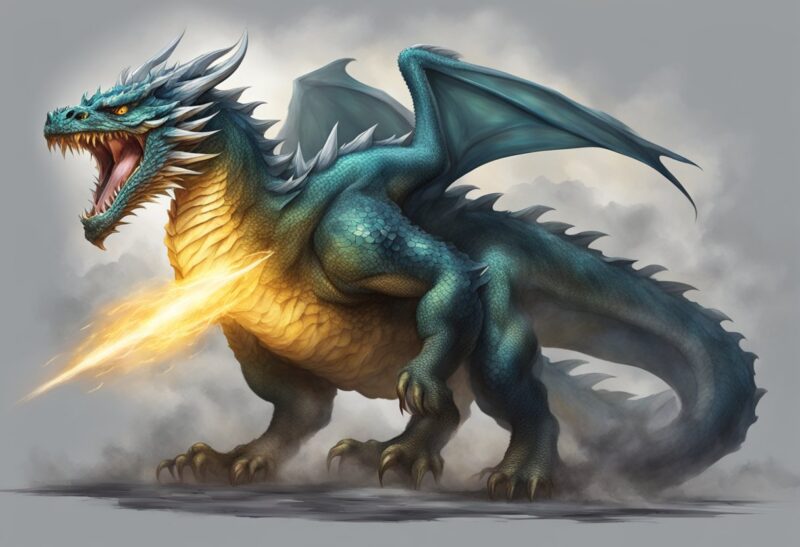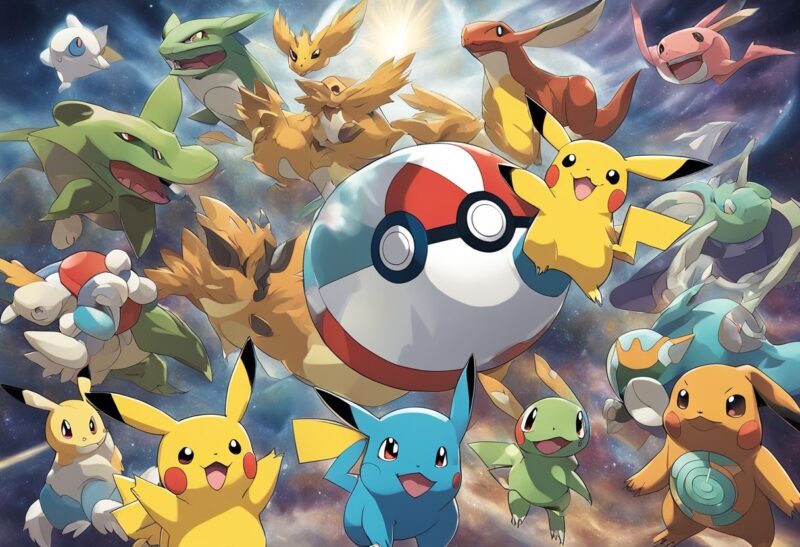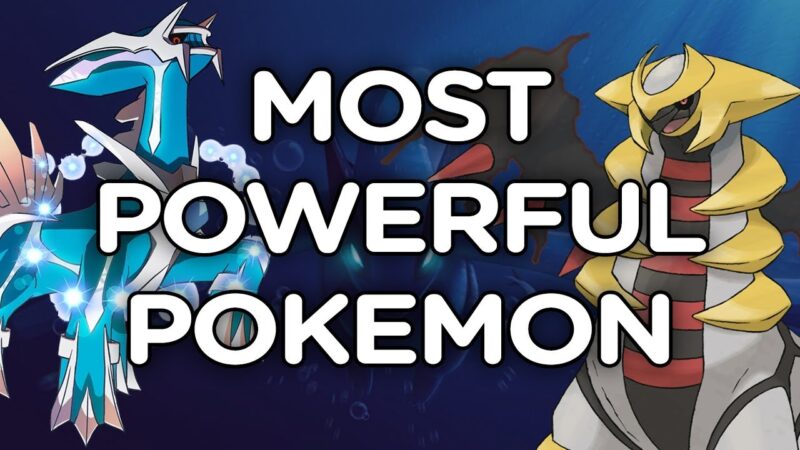The Pokémon franchise has captivated fans around the world with its wide array of creatures each boasting different abilities, types, and forms. Throughout its expansive universe, discussions about the “Most Powerful Pokemon of All-Time” have been a central topic for both casual enthusiasts and competitive players. These power debates take into account various aspects such as Legendary status, unique moves, statistical advantages, and impact within the Pokémon community.

Within the lore of the Pokémon series, concepts like Mega Evolution and alternate forms have added depth to the already complex hierarchy of Pokémon power. The constant introduction of new Pokémon and mechanics with each game generation keeps the conversation about the most powerful contenders ever-evolving. Moreover, the success of Pokémon in competitive play and other media has further influenced the perceptions of the power and capabilities of these legendary creatures.
Key Takeaways
- The power of a Pokémon is multifaceted, encompassing lore, game mechanics, and competitive viability.
- The discussion of the strongest Pokémon includes Legendary and Mythical status, alternate forms, and the constantly evolving game metagame.
- Pokémon’s influence extends beyond the games, affecting their perceived strength in competitive play and popular culture.
The Concept of Power in the Pokémon Universe
The Pokémon universe classifies the might of its creatures not just through sheer strength but also by their diverse abilities and the impact they can have on an opponent. This concept of power is multifaceted, considering not only a Pokémon’s hit points and attack stats but also their strategic utility in battle.
Strongest and Most Powerful Pokémon: Pokémon like Arceus hold a legendary status due to their lore and unmatched capabilities. As the creator of the universe, Arceus epitomizes the zenith of power.
- Key Abilities: Pokémon abilities play a crucial role in determining the outcome of battles. For instance, Alakazam, known for its exceptional offensive capabilities, uses its intelligence as a strategic advantage.
- Measuring Power: The power levels of Pokémon are not static. They evolve through battles and can gain strength through Mega Evolutions, transforming them into even more formidable opponents.
| Category | Example Pokémon | Noteworthy Ability |
|---|---|---|
| Psychic Power | Alakazam | Intelligence |
| Legendary Might | Arceus | Creation |
| Elemental Force | Kyogre and Groudon | Weather manipulation |
In essence, the measure of power within the Pokémon universe is as complex as it is fascinating. It extends beyond raw strength, requiring a deeper understanding of individual Pokémon, their unique abilities, and how effectively they can counter an opponent. Each Pokémon brings its distinct strength to the fold, contributing to a dynamic landscape of power and prowess in the Pokémon world.
Legendary and Mythical Pokémon
Legendary and Mythical Pokémon are some of the most formidable and iconic creatures within the Pokémon universe, often possessing unrivaled power and unique abilities. Many play pivotal roles in the lore and are sought after for their strength in battles.
Origin and Importance
Legendary Pokémon are integral to the mythology of the Pokémon world. They’re deeply woven into the history of the regions they inhabit and often embody natural phenomena or cosmic forces. Arceus, for example, is known as ‘The Original One’ and is said to have shaped the Pokémon universe. Meanwhile, Dialga, Palkia, and Giratina represent time, space, and antimatter respectively, signifying their dominion over the fundamental aspects of reality.
Mythical Pokémon, like Legendary Pokémon, are incredibly rare and usually only available through special distributions. They’re often central to the plot of movies and games, such as Mewtwo in “Pokémon: The First Movie,” where its creation and search for purpose are key themes.
Examples and Abilities
The abilities of Legendary and Mythical Pokémon are as diverse as the creatures themselves. Here are a few standout examples:
- Rayquaza: This Legendary Pokémon from the Hoenn region can calm the other members of the weather trio, Kyogre and Groudon, who control the sea and land.
- Lugia and Ho-Oh: Known as the tower duo, they represent the sea and sky. Lugia’s Aeroblast and Ho-Oh’s Sacred Fire showcase their control over these elements.
Other formidable Legendary Pokémon include:
- The Legendary Beasts (Entei, Raikou, and Suicune): Each possesses abilities that reflect the event that gave birth to them (fire, lightning, and water).
- The Tao Trio (Reshiram, Zekrom, Kyurem): Representing truth, ideals, and the absence of both, they have strong ties to Unova’s history.
- The Aura Trio (Xerneas, Yveltal, and Zygarde): They are the life, destruction, and balance of the ecosystem.
Each Legendary Pokémon is also often associated with a specific type, enhancing its mythology and battle strategy, such as Articuno, Zapdos, and Moltres being Ice, Electric, and Fire types respectively.
Pseudo-Legendary Pokémon
Pseudo-legendary Pokémon are a distinctive group known for their high base stats that rival those of many legendary Pokémon. They typically have a three-stage evolution line and are often among the most powerful Pokémon in competitive play.
Characteristics
Pseudo-legendary Pokémon possess a few unique characteristics that set them apart from other Pokémon categories. Each member of this esteemed group boasts a base stat total of 600, which is not augmented by any Mega Evolutions. These Pokémon usually experience a slow rate of growth, requiring more experience points to reach their formidable final forms.
Another key feature is their three-stage evolution process, which starts with a basic form and culminates in a significantly more powerful final form. A majority of pseudo-legendary Pokémon are of the dragon-type, notorious for their offensive prowess and resistance to many other types.
Notable Members
- Dragonite: As the original pseudo-legendary introduced in Generation I, Dragonite is a dragon-type Pokémon revered for its well-rounded stats and empathetic nature. It evolves from Dratini and then Dragonair and is known for its ability to learn a variety of powerful moves.
- Tyranitar: Hailing from Generation II, Tyranitar’s pre-evolutions are Larvitar and Pupitar. Resembling a towering dinosaur, Tyranitar is a rock/dark-type renowned for its Mega Evolution, which augments its already impressive stats. Tyranitar’s sandstorm-summoning ability can be a game-changer in battles, offering a strategic advantage.
The group of pseudo-legendary Pokémon serves as a testament to their strength and competitive edge. Both Dragonite and Tyranitar, alongside other members of this elite category, have left an indelible mark on the world of Pokémon.
Mega Evolution and Alternate Forms
Mega Evolution and alternate forms like Primal Reversion represent some of the most significant enhancements affecting Pokémon power dynamics. These transformations often result in massive spikes in a Pokémon’s stats and can even change their abilities and types, marking them as apex contenders in battles.
Mega Evolution Explained
Mega Evolution is a temporary transformation affecting certain Pokémon, significantly enhancing their abilities in battle. To initiate a Mega Evolution, a Pokémon must hold a corresponding Mega Stone, and its trainer must possess a Key Stone. When these conditions are met, a strong bond allows for this empowering transformation. For instance, Mega Alakazam sees a notable increase in its already formidable Special Attack and Speed stats. Similarly, Mega Tyranitar gains amplified Defense and Attack, fortifying its role as a tank and damage dealer.
Mega Evolution transformations only last for the duration of the battle, with Pokémon reverting to their original state afterward. The impact of this mechanic on battle strategies cannot be understated—it alters the course of battles, forcing opponents to adapt to the temporary yet potent enhancements.
Primal Reversion and Others
Apart from Mega Evolution, another transformative power known as Primal Reversion also exists, which applies exclusively to the Legendary Pokémon Primal Groudon and Kyogre. Primal Reversion is not a temporary battle phase but a permanent return to a Pokémon’s original, primordial form, which precedes Mega Evolution. It is triggered by the Pokémon holding a unique item—such as Groudon’s Red Orb—which leads to a leap in its stats and, in Primal Groudon’s case, a change to a dual Ground/Fire typing along with the powerful Desolate Land ability.
While the concept of Mega Evolution did not continue into later generations, its inclusion in Generation VI and Generation VII games has left an indelible mark on the Pokémon franchise. These enhancements provide some Pokémon with the tools necessary to shift the tides of battle, cementing their place as some of the most powerful creatures in the Pokémon world.
Comparing Pokémon by Type and Generation
This section explores the dynamic strengths and weaknesses inherent to Pokémon types and how Pokémon’s powers have evolved across generations.
Type Advantages
Among the many types in the Pokémon universe, the Dragon type stands out for its formidable offensive capabilities and resistance to many other types. Notoriously, Dragon-type Pokémon were nearly unbeatable in Generation I due to the lack of strong Ice and Dragon moves. However, the introduction of Fairy-type Pokémon in Generation 6 provided a new weakness for Dragon types to contend with.
The Psychic-type, once dominant in early generations due to limited weaknesses and powerful moves, has seen a balancing over the years with the introduction of Bug, Ghost, and Dark-type moves that can exploit its vulnerabilities.
In contrast, Normal-type Pokémon can appear less remarkable due to their lack of super-effective moves and a vulnerability to Fighting-type moves. Yet, they benefit from only having one weakness and are immune to Ghost-type attacks.
Here’s a succinct look at how certain types coupled with specific movesets fare against each other:
- Fire/Flying: Strong against Bug, Grass, Fighting, and Steel-types but weak to Water, Electric, and Rock-type moves. Famous representatives include Charizard and Moltres.
- Dark/Flying: This type combination yields high resistance to Psychic and Ghost-type moves and is exemplified by Pokémon like Yveltal from Generation 6.
Generational Power Creep
As the Pokémon franchise advanced from Generation I to Generation 8, the concept of ‘power creep’ became evident, where newer Pokémon tend to feature higher base stats or more versatile abilities compared to their predecessors.
For instance, Generation 8 introduced powerful species with significant stat increases and unique moves that redefine competitive play. Consider the impact of certain Generation 8 Pokémon that have higher stats and more optimized move pools, challenging the established hierarchy of power from previous generations.
The distinctions in power and abilities between generations tend to reflect the evolving nature of the Pokémon world, with a concerted effort by game designers to maintain a balanced and competitive gameplay environment.
Pokémon in Competitive Play
In the sphere of competitive Pokémon battles, a player’s mastery over the metagame and strategic implementation of moves like Quiver Dance are pivotal. Decisions are often based on a Pokémon’s total base stats and capabilities to transform the tide of battle.
The Metagame
The competitive Pokémon landscape, commonly referred to as the metagame, revolves around strategic layers that influence which Pokémon are deemed superior. These decisions are grounded on the total base stats (TBS), a numerical value summing a Pokémon’s individual stats, which provide a baseline for assessing battle readiness.
- High TBS Pokémon: Typically at the apex of competitive tiers, these Pokémon boast formidable base stats, granting them the prowess to dominate in battles.
- Strategic Variants: Some Pokémon may not have the highest TBS but leverage moves like Quiver Dance to amplify their stats, transforming a seemingly average contender into a formidable one.
Viable Strategies
Strategic proficiency in competitive play involves more than understanding base stats; players must develop viable strategies that can adapt to opposing tactics.
- Transformative Tactics: Utilization of moves that can significantly transform a Pokémon’s performance in battle, such as stat-boosting moves or those that change a Pokémon’s type, is critical.
- Adaptation: Countering metagame trends requires a deep understanding of potential matchups and real-time strategy adjustments, often playing mind games with one’s opponent.
Pokémon with the ability to shift the momentum or alter their role mid-battle can offer surprising advantages, making flexibility a key trait for competitive teams.
Influence of Pokémon in Other Media

The Pokémon franchise has made a significant mark in various media platforms extending far beyond its origins as a video game. Its influential presence can particularly be witnessed in the anime industry and the mobile gaming landscape.
Pokémon in the Anime
The Pokémon anime series has broadcasted globally, introducing the essence of the franchise to a wider audience. Iconic characters like Ash Ketchum and his companion Pikachu have become household names. The anime has played a pivotal role in promoting the Pokémon brand, which has led to the production of over a thousand episodes, movies, and specials. This massive reach solidifies the status of Pokémon as a cultural phenomenon and propels its ongoing relevance.
Pokémon GO’s Impact
Pokémon GO revolutionized mobile gaming by integrating augmented reality, encouraging players to explore real-world locations to catch Pokémon. The game’s launch was a landmark moment, racking up over a billion downloads globally. It transformed public spaces into communal gaming hubs, bringing a diverse crowd together and creating a shared gaming experience. The success of Pokémon GO proved the franchise’s adaptability and enduring popularity outside traditional video game formats.
Unique Abilities and Moves of Top Pokémon
When examining the Most Powerful Pokémon of all time, it’s essential to highlight the unique abilities and moves that set them apart from the rest. These characteristics often play a critical role in their competitive success.
Alakazam is renowned for its incredible Speed and Special Attack stats, wielding psychic moves like Psychic and Future Sight with devastating effect. With its Synchronize ability, it can pass on any status condition inflicted on it to the foe, making it a strategic player in battles.
Machamp, on the other hand, thrives on brute force. Its No Guard ability ensures moves by or against Machamp will never miss, and its signature move, Dynamic Punch, capitalizes on this by delivering a powerful hit alongside guaranteed confusion.
Gengar haunts the battlefield with its Levitate ability, rendering it immune to Ground-type moves. This Ghost/Poison Pokémon enjoys access to a diverse move set, with the deadly move Shadow Ball taking full advantage of its high Special Attack.
For Gardevoir, its Trace ability can copy an opponent’s ability, which can drastically shift the tide of battle. Its signature move, Moonblast, provides a chance not only to deal Fairy-type damage but to lower the target’s Special Attack stat.
Kyurem, a legendary Pokémon, carries the Pressure ability which rapidly depletes the opponent’s move PP. It’s also noted for its unique moves, Glaciate and the more powerful Ice Burn or Freeze Shock, depending on its form.
Lastly, Golem stands strong with its Sturdy ability, ensuring it can survive an otherwise knockout blow with 1 HP. It typically employs moves like Stone Edge and Earthquake to make the most of its formidable Attack and Defense stats.
Regional Variants and Recent Discoveries
The Pokémon universe continuously evolves, bringing forth new variants and species that redefine strength and versatility. With Game Freak at the helm, innovative twists on classic creatures have surfaced, particularly through regional variants, each with unique abilities and typings that stand out from their Generation I counterparts.
Alola Forms
In the Alola region, a tropical climate led to the discovery of distinct forms of known Pokémon. These variants not only boast different appearances but also altered typing and abilities. For instance, an Alolan Vulpix, departing from its original fire type, thrives as an ice type in the snowy mountain peaks of Alola. The strategic nuances of these forms add layers to competitive battling, making them fan favorites and often changing the dynamics of a match.
Newest Additions
The Pokémon roster expanded significantly with the introduction of Galarian and Unovan variants, as well as completely new entities like Zamazenta and Eternatus. The latter, with its massive Eternamax form, has been a game-changer in terms of raw power. Recent games have seen the introduction of titans such as Miraidon and Koraidon, whose sheer might and unique move sets carve them a place among the mightiest. Meanwhile, Zygarde, with its adaptable forms, demonstrates the rich depth of lore and power diversity within the different regions of the Pokémon world. These discoveries continually shape the meta and influence the strategies of Trainers globally.
Fan-Favorite and Iconic Pokémon
Within the global phenomenon of Pokémon, a select few have risen above the rest in terms of popularity and lasting impact on the franchise. These characters are treasured not just for their strength in battle, but for their significant roles in animated series, videogames, and the Pokémon community.
Popularity and Impact
Pikachu, The Pokémon Company’s electric-type mascot, stands at the pinnacle of fan-favorite Pokémon. Distinguished by its yellow fur and lightning bolt-shaped tail, Pikachu is synonymous with the brand itself. With appearances from the television series to countless merchandise, Pikachu is a cultural icon that transcends the realm of video games.
Charizard, the fully evolved form of Charmander, wields a powerful image with its dragon-like appearance and ability to expel fire hot enough to melt boulders. Known for its majestic and fearsome design, Charizard carved its niche as one of the most sought-after and admired Pokémon among fans, further emphasized by its presence in competitive play and various media adaptations.
Eevee and its multiple evolutions, commonly referred to as Eeveelutions, have a unique appeal due to the wide variety of types they can evolve into, including the immensely popular Vaporeon, the Water-type Eeveelution known for its fluid, aquatic design.
Dragonite, another dragon-like Pokémon known for its friendly appearance contrasting with its powerful abilities, has been a fan favorite since its debut in the early games. Its pre-evolved form, Kingdra, also holds a special place among fans for its regal seahorse appearance and notable versatility in battles.
Among other fan-favorites, Gyarados is notable for its transformation from the weak Magikarp to a formidable Water/Flying-type Pokémon, recognized for its serpentine design and fearsome demeanor. Volcarona garners attention with its unique Fire/Bug typing and visually striking sun motif, earning a place among the most memorable and powerful Pokémon.
Beyond Strength
While the power and abilities of Pokémon like Ditto, with its singular capacity to transform into any other Pokémon, are significant, their cultural impact extends beyond the games. Ditto embodies the essence of versatility, appearing in memes, merchandise, and as an important part of any strategic player’s team, highlighting the multifaceted appeal of these creatures.
Eeveelutions continue to be a subject of adoration not only for their adaptability in competitive play but also for their charming designs which have generated considerable attention in the form of plushies, figures, and artwork, showcasing the community’s creativity and dedication.
The enduring popularity of these Pokémon is a testament to their design, stories, and the emotional connections they forge with fans around the world, making them transcendent of the concept of mere “power” in the Pokémon universe.
Frequently Asked Questions
In the world of Pokémon, fans often debate which creatures are the most powerful. This section aims to address the common questions regarding the strongest Pokémon across different contexts and formats.
Which Legendary Pokémon ranks at the top in terms of strength?
Arceus is typically regarded as the most powerful Legendary Pokémon, considered the creator of the Pokémon universe with the ability to change its type depending on the Plate or Z-Crystal it holds.
What is the highest-rated Pokémon card in terms of power?
The Pokémon card ranking top in power is often subjective to the game’s meta, but the Shadow Lugia Promo Card from Pokémon XD: Gale of Darkness is infamous, boasting an astonishing 300 HP and a powerful move costing zero energy despite it not being tournament legal.
Aside from the ultimate spot, which Pokémon holds the title of being the next most powerful?
That title is often debated but is frequently attributed to Mewtwo, given its superior psychic abilities and prominent role as a formidable opponent in various Pokémon games and media.
What non-Legendary Pokémon make the list of top ten strongest?
Pokémon like Dragonite, Tyranitar, and Metagross are often referred to when discussing non-Legendary Pokémon with immense strength, offering formidable stats and versatile move-sets in battle.
Can Mewtwo be considered the peak of Pokémon battle power?
Mewtwo is indeed considered one of the peak examples of Pokémon battle power, known for its exceptional stats and the lore of being the strongest Pokémon before the introduction of newer generations and Legendary Pokémon.
In Pokémon Go, which creature is recognized as the most formidable?
In Pokémon Go, the most formidable creatures are often the Legendary Pokémon with high CP potential. Pokémon like Mewtwo, Groudon, and Rayquaza are highly sought after for their power in raids and battles.







